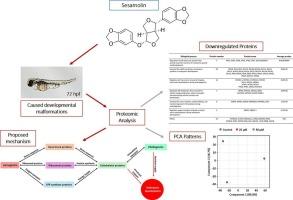Proteomic responses to acute sesamolin exposure in zebrafish embryos
IF 4.3
3区 环境科学与生态学
Q2 BIOCHEMISTRY & MOLECULAR BIOLOGY
Comparative Biochemistry and Physiology C-toxicology & Pharmacology
Pub Date : 2025-08-15
DOI:10.1016/j.cbpc.2025.110322
引用次数: 0
Abstract
Sesamolin, a lignan with known pharmacological benefits, has been extensively studied for its neuroprotective, antioxidative, and anticancer properties. This study builds upon previous investigations into the acute toxicity of sesamolin, presenting a detailed examination of its effects on zebrafish embryonic development through a proteomic approach. Zebrafish embryos were exposed to 25 and 50 μM concentrations of sesamolin for 72 h, resulting in significant developmental abnormalities, including yolk sac edema, spinal curvature, blood clots, and defects in erythropoiesis. Proteomic analysis revealed a dose-dependent downregulation of 162 proteins, including vital clusters such as vitellogenins, ribosomal proteins, cytoskeletal proteins, heat shock proteins, hemoglobin proteins, and ATP synthase. These alterations are linked to disrupted protein synthesis, impaired structural integrity, energy production deficits, and abnormal embryonic nutrient utilization. The study suggests that sesamolin exerts its toxic effects by interfering with key molecular mechanisms essential for normal embryogenesis, specifically affecting protein expression involved in development, cell structure, and metabolic processes. These findings provide novel insights into the potential adverse effects of sesamolin on embryonic development and highlight the need for further research to elucidate the underlying molecular pathways and assess the compound's broader toxicological risks, particularly in relation to human health.

斑马鱼胚胎急性芝麻素暴露的蛋白质组学反应
芝麻素是一种已知具有药理作用的木脂素,因其神经保护、抗氧化和抗癌特性而被广泛研究。本研究建立在先前对芝麻素急性毒性的研究基础上,通过蛋白质组学方法详细研究了其对斑马鱼胚胎发育的影响。将斑马鱼胚胎暴露在25 μM和50 μM浓度的芝麻素中72小时,结果显示发育异常,包括卵黄囊水肿、脊柱弯曲、血凝块和红细胞生成缺陷。蛋白质组学分析显示162种蛋白质的剂量依赖性下调,包括重要的蛋白簇,如卵黄蛋白原、核糖体蛋白、细胞骨架蛋白、热休克蛋白、血红蛋白和ATP合成酶。这些改变与蛋白质合成中断、结构完整性受损、能量生产缺陷和胚胎营养利用异常有关。研究表明,芝麻素通过干扰正常胚胎发生所必需的关键分子机制来发挥其毒性作用,特别是影响与发育、细胞结构和代谢过程有关的蛋白质表达。这些发现为芝麻素对胚胎发育的潜在不利影响提供了新的见解,并强调需要进一步研究以阐明潜在的分子途径并评估该化合物的更广泛的毒理学风险,特别是与人类健康有关的毒理学风险。
本文章由计算机程序翻译,如有差异,请以英文原文为准。
求助全文
约1分钟内获得全文
求助全文
来源期刊
CiteScore
7.50
自引率
5.10%
发文量
206
审稿时长
30 days
期刊介绍:
Part C: Toxicology and Pharmacology. This journal is concerned with chemical and drug action at different levels of organization, biotransformation of xenobiotics, mechanisms of toxicity, including reactive oxygen species and carcinogenesis, endocrine disruptors, natural products chemistry, and signal transduction with a molecular approach to these fields.

 求助内容:
求助内容: 应助结果提醒方式:
应助结果提醒方式:


